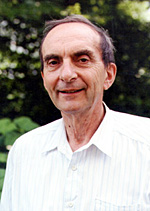Prize Recipient

Gerald E. Brown
State University of New York, Stony Brook
Citation:"For his insightful analyses of the effects of various nuclear constituents on nucleon interactions and nucleon structure, and his contributions to new viewpoints on supernovae, neutron stars, and black hole formation."
Background:
For his insightful analyses of the effects of various nuclear constituents on nucleon interactions and nucleon structure, and his contributions to new viewpoints on supernovae, neutron stars, and black hole formation.
Dr. Brown did fundamental work in atomic physics, beginning with the self-ionization of the vacuum with Geoff Ravenhall in 1951, electron-electron interactions and the Lamb Shift in heavy atoms and accurate evaluation of Rayleigh scattering. Together with Tom Kuo he worked out effective interactions between nucleons in nuclei, and with Mark Bolsterli the giant dipole state. Together with Mannque Rho and Dan Olaf Riska he introduced chiral invariance into nuclear physics. In twenty-some papers with Hans Bethe he worked out the collapse of large stars, evolution of compact binaries and, most recently, the evolution of black holes in the Galaxy, as well as a theory of gamma ray bursters.
Dr. Brown has been awarded the Tom W. Bonner Prize from the American Physical Society, the John Price Wetherill Medal of the Franklin Institute and the Max-Planck Medaille from the German Physical Society. He is a member of the Royal Danish Academy, the Finnish and Norwegian Societies of Science and Letters, and the U.S. National Academy of Science. He has honorary doctorates from Helsinki, Birmingham and Copenhagen Universities.
Selection Committee:
Robert V Wagoner (Chair), Akif Baha Balantekin, Talmi Igal ('00 Recipient), Gerald Garvey (Vice Chair), Giovanni Fazio
